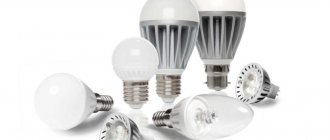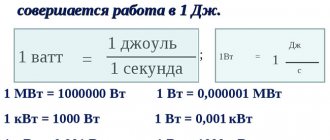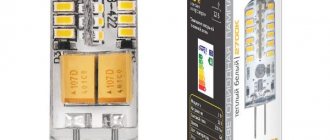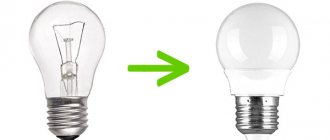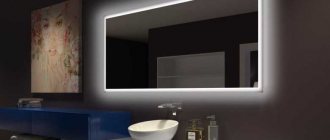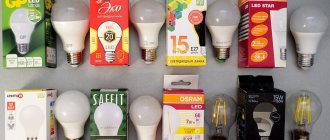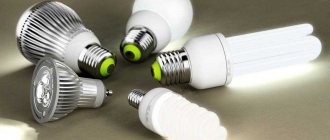At the time of purchasing an incandescent light bulb, the number of watts indicated on the packaging only gives consumers an accurate indication of how much they will have to pay for electricity. One thing we know for sure is that the higher the value, the brighter the lamp.
But the rules have changed. An LED, which uses 60 watts of energy, is in no way comparable to an equivalent incandescent bulb. In fact, 60W LED fixture might just blind you.
Let's start with a table that provides detailed information on how to choose good LED light bulbs based on their wattage.
Glow color
LED lamps, unlike incandescent lamps, can have different glow colors. Therefore, it is important to decide which color is suitable and comfortable for you.
Warm or cold. If everything is more or less clear with warm light, it corresponds to a color temperature from 2700 to 3000 Kelvin. This is very similar to the lighting from a regular incandescent light bulb. More details
With cold colors everything is more complicated. There can be two types of cold flowers:
- natural or neutral white 4000-4500 kelvin
- daytime from 6000 to 6500 kelvin
The higher the color temperature, the more lumens the LED produces and, accordingly, the brighter the lamp shines at the same power.
The difference can reach 10-15%. Therefore, it seems to be more profitable to buy fluorescent lamps. You get more light for the same money.
However, can you rest and relax at home under the bluish, cold light that resembles the lighting in an operating room? Most likely no.
It just so happens that people find warm light more pleasant, such as from incandescent lamps or a fireplace. But at the same power, it is the least bright.
Therefore, the most popular is neutral or natural white 4000 - 4500K.
Colorful temperature
The unit of color temperature is Kelvin (K). You need to pay close attention to this parameter, since the method of using the light source for the home depends on it.
The typical range of color temperature indicators is in the range from 2000 to 10000 K:
- Warm : 1800 - 3900 K, an excellent option for installation in recreation areas.
- Neutral : 4000 - 5300 K, goes well with natural light.
- Cold : 5400 - 6700 K, gives a bluish tint with frosty notes.
Lamps with a low color temperature are ideal for living rooms, bedrooms and other rooms where you can relax. And for offices, classrooms and workrooms, LEDs with parameters above 5000 K
Supply voltage
There are lamps that are produced only for 220 volts:
- models with G9 base
- reflector lamps R39, R50, R63, R80
And there are models that are available for both 12 volts and 220V. Moreover, their shapes are almost identical.
- capsule G4
- reflector MR16 with GU 5.3 base
- GX 53 tablets
Types of socles
In the marking of LED products, the letter indicates the type of base, and the number indicates the diameter, or the distance between the contacts. Basic information is presented in the table:
| Thread | Photo | Description |
| E27 , 27 mm | Classic plinth with screw-on Edison thread. Used in most home lamps. | |
| E14 , 14 mm | Widely used in everyday life, most often in low-power installations, for example, tabletop appliances, spotlights. | |
| GU10 , 10 mm | Products with GU10 , GU5.3 and G4 completely replace outdated halogen bulbs of this type. | |
| GX53 , 53 mm | Base for overhead lamps, which are used for suspended ceilings and furniture. |
Power
In recent years, there has been a misconception that the brightness of LED light sources is comparable to conventional incandescent lamps in a ratio of 1 to 10.
That is, if you need to replace a 100W light bulb, all you need to do is find a 10W LED model. Then it will give the same amount of light and you will not lose in brightness.
In fact, this is far from the case. A lot depends on:
- shapes - for example, reflective gives directional light, while pear shapes scatter it more
- flasks – matte or transparent
- scattering angle
- glow colors
At the same time, do not forget that each lamp shape has its own optimal power.
- for a ball or candle it is 5-6 W
- for pear or tablet GX 53 from 8 to 10W
- for MR16 reflectors this is 4-5W
- for capsules with G9 socket 2-2.5W
Exceeding these recommendations entails either an increase in size or a sharp reduction in service life.
Therefore, the optimal ratio of power equivalence between LED types and simple ones is 1 to 8.
If you do not have enough light, then you should not chase more powerful lamps. It would be best to add a couple of additional lamps.
What costs does a traditional lighting system require?
A traditional household lighting system includes 220V wiring, switches, lighting fixtures, and lamps. If the power of all lighting devices exceeds 3.5 kW, the system is divided into subsystems that are connected to a separate residual current device (relevant for large country houses).
When using incandescent lamps, the consumer can choose lighting fixtures at his own discretion. The final cost of the system depends on their price. Lamps are sold at different prices, depending on the design and manufacturer. The price of incandescent lamps also varies. For products from Russian manufacturers, the average value is 15 rubles.
Other manufacturers have different prices:
- Philips 60W – 30 rub., 40W – 35 rub., color 10W – 38;
- “candle” Foton 25W – 29 rubles;
- “pear” Osram 75W – 31 rubles, 40W – 32.
The final cost will depend not only on the area of the home and the power of the lighting fixtures, but also on the preferences and financial capabilities of the family. When purchasing expensive lamps and switches, dimmers, and imported light bulbs, the initial costs will increase not only during purchase, but also during the installation process. To include dimmers in the circuit, you will have to invite a specialist who knows exactly how to do this work.
Attention! Energy consumption can be affected by illuminated switches and dimmers. The former consume a small amount of watts, the latter allow, if necessary, to reduce the intensity of the glow while simultaneously reducing the power.
Flask
Which lamps are better - with a matte or transparent bulb? The LED is a point and very bright light source. If the lamp is visible in a chandelier or lamp, for example it is directed downward, then with a transparent bulb an irritating effect may occur, similar to a welding arc.
However, the matte diffuser does not have this drawback. Decide what is best for you - even, soft and diffused light, or very bright.
An exception is crystal chandeliers and similar lamps.
For them, point and sparkling light sources are better, which give a play of light on the edges of crystal elements.
Color rendering index
The color rendering index (Ra) refers to the ability of the light produced to convey the shades of objects without distortion. The higher the better. The maximum value of the indicator is 100 . 80 is considered very good quality . This is quite enough for all household needs.
In places where a lot of light with maximum color rendering , lamps with a Ra index above 90 .
Dimming
Controlling the brightness of lighting using a dimmer is a very useful and convenient feature. However, most LED lamps do not support this feature.
Finding a dimmable LED lamp of the desired shape, size, power and color is not easy and is almost always expensive.
It should be taken into account that dimming occurs by controlling the frequency parameters of the supply voltage.
And this will definitely cause pulsation on the lamp.
If you don't want ripples, skip dimming.
You can control the brightness in another way - by turning various lighting groups on and off.
Although this is less elegant, it is more effective and safer for your health.
Ripple
How do you know if a lamp has pulsation? Every major store has the ability to check product functionality.
Turn on the light bulb and just look at it through your mobile phone camera.
If there are stripes on the screen, the lamp is pulsating.
It is not advisable to use such products in residential premises. Their purpose is to illuminate entrances, garages, corridors and utility rooms.
If there are no stripes, then the lamp does not pulsate.
Quality
Let's say you have decided on all the above points. How can you tell a high-quality light bulb from a low-quality one?
If the lamps are the same in power and size, do not have pulsation and are very similar in appearance, then its weight can be considered an indirect sign of quality.
Estimate the weight in your hands or compare the data on the packaging. The lamp whose weight is greater is potentially better. More weight is a sign of a more massive cooling radiator.
Better heat dissipation means longer service life. If the product is powerful, but at the same time “weightless,” then this is a clear sign of a short-lived product.
Energy efficiency class
A characteristic that determines the class of current consumption, where the marking A means a high level of energy saving, but there are also additional indices A+ and A++ , which are applied to the packaging of lamps that require minimal electricity consumption.
The level of electricity consumption by class is clearly presented in the table:
| Class | Consumption level |
| A | 20-50 % |
| B | 50-75 % |
| C | 75-90 % |
| D | 90-100 % |
| E | 100-110 % |
| F | 110-125 % |
| G | more than 125% |
To produce the same luminous flux, a compact fluorescent lamp marked Class A consumes only 1/3 C halogen lamp .
Life time
Each manufacturer indicates the service life on the packaging. However, even famous brands do not indicate periods of more than 25,000 hours of operation.
If on average a light bulb shines for 5-6 hours a day, then that’s already more than 10 years!
When the packaging states operating times of 30,000 or 50,000 hours, and the manufacturer’s warranty is only 12 months, then it’s clearly worth thinking about.
Lumens
On the packaging of LED products, manufacturers often indicate the illumination in lumens and what kind of conventional light bulb this corresponds to. How to correctly understand such inscriptions?
100W incandescent lamps produce a minimum of 1200 - 1300 lumens. If it is written on the packaging that a 10W light bulb produces more than 700 lumens and at the same time is the same as a simple 100-watt light bulb, then this is a clear sign of deception.
Study the table of correspondence between different types of lamps with their power and output lumens, and check the declared data from class=”aligncenter” width=”720″ height=”615″[/img]
If it doesn't work, just don't buy it. If it is close to the specified parameters, then the lamp should be of high quality.
